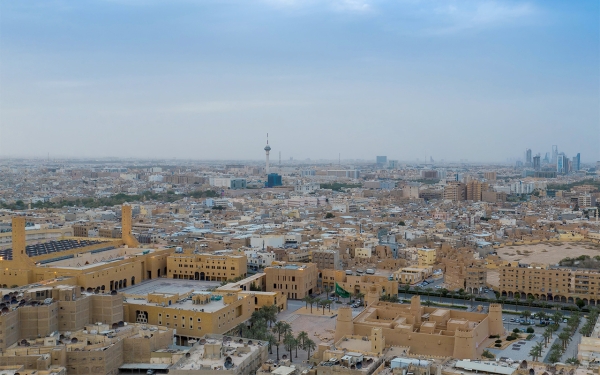
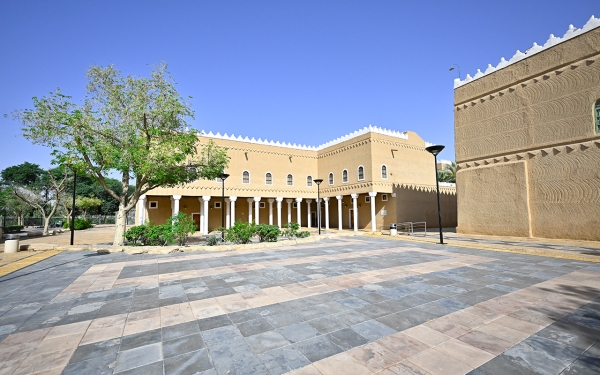
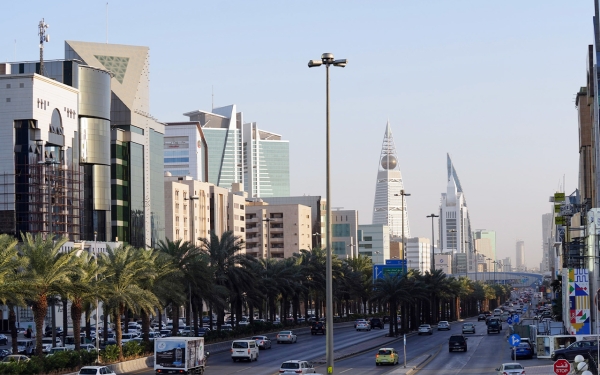
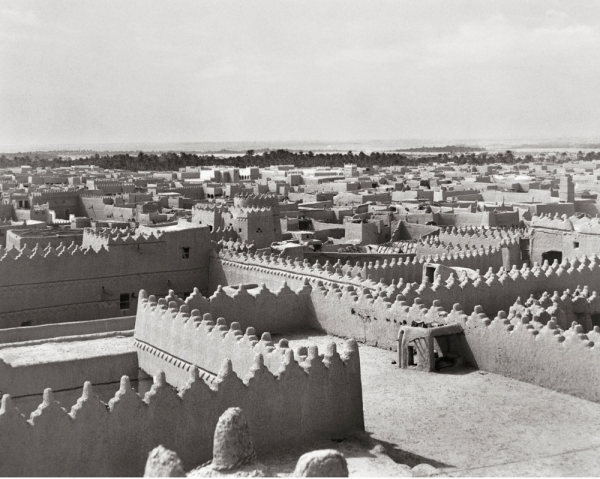
Riyadh City (romanized: Ar Riyāḏ) is the capital of the Kingdom of Saudi Arabia and its largest city in terms of population. It is one of the most densely populated capitals in the world. Located near ad-Dir'iyyah, the capital of the First Saudi State, together they laid the foundation for three states: the First Saudi State, the Second Saudi State, and the Kingdom. In addition to its central location at the heart of the Kingdom, it houses al-Hukm Palace.
For over fifty years, the Emirate of Riyadh was led by one governor who later became its king, and he is the Custodian of the Two Holy Mosques, King Salman Bin Abdulaziz Al Saud, the seventh King of the Kingdom. Administratively, the capital falls under the Emirate of Riyadh Province, alongside twenty-two other governorates. Although the name Riyadh is used synonymously with the administrative province, the capital Riyadh only constitutes 1 percent of its land.
Riyadh represents a central hub in the Kingdom, with 45.8 percent of the population living there. It is the headquarters for the main administrations of most banks, companies, and government institutions in the Kingdom. It is also the primary center for government activities and expenditure, housing the Kingdom's sovereign wealth center, the Public Investment Fund, which finances vital projects and companies.
Riyadh is considered one of the centers for political decision-making on regional, Arab, Islamic, and international levels. It is the seat of government for a country classified among the top twenty economies in the world. On its land, there are government ministries, international missions, global organizations, and embassies. It is also the headquarters of the Gulf Cooperation Council for the Arab States of the Gulf.
Riyadh is viewed as the main landscape reflecting the Saudi Vision 2030. Megaprojects target 49 percent of its lands. On its southwest edge lies the Qiddiya project, one of the largest leading tourist destinations in the Kingdom. Additionally, there's the Riyadh Metro, which is the first of its kind in the Kingdom and the second in the Gulf countries. In the center of Riyadh is the King Salman Park project. Upon completion, it will be the largest urban park in the world, covering an area of over 16 km².
History of Riyadh City
Riyadh before the common era
The earliest mention of Riyadh in historical sources dates back to 715 BCE, in the context of the mention of the city of Hajar, the capital of the Yamama region. The earliest archaeological indications of the oldest human settlements in Riyadh City point to the tribes of Tasm and Jadis; that is, approximately 2,500 years ago. Their relics, remnants of forts, and castles can be seen from those who lived in the early tenth century.
Historical narratives indicate that the Jadis tribe settled in al-Khadrma, a region located near the current site of al-Kharj. As for the Tasm tribe, they settled near a tributary of Wadi Hanifa that flows south, which was known as al-Khadraa or al-Aridh. Historians consider the tribes of Tasm and Jadis to be among the extinct original Arabs (al-Arab al-Ba'ida). They trace both tribes back to a common ancestor, Sam Bin Noah. They say that Tasm and Jadis are the sons of Iram Bin Sam. Some believe that Tasm is attributed to al-Awz Bin Sam and that it is older than Jadis.
Archaeologists have found artifacts near ath-Thumamah that confirm the existence of a settlement dating back to eight thousand years ago, based on discoveries that included stone structures, millstones, and stone tools. The domestication of the Arabian camel and the horse as means of transportation led to the establishment of trade routes around 3500 BCE. Both the horse and camel played a fundamental part in the fabric of Arab life and culture, and they also enhanced the development of long-distance trade.
Riyadh from the Medieval to the Islamic Era
Riyadh City was built on the ruins of the city of Hajar, situated atop a terrain between Wadi al-Wotr, later named al-Batha, and Wadi al-Aridh (Wadi Hanifa). This area was known as the base for the region of al-Yamama. The name Hajar was attributed to Ubaid Bin Tha'laba al-Hanafi, who migrated to this area and found it containing gardens and palaces devoid of their inhabitants. These structures are traced back to the residents of the tribe of Tasm. Its disappearance is attributed either to the Himyarite invasions that originated from Yemen or due to droughts and epidemics. Ubaid Bin Tha'laba al-Hanafi took for himself and his people from the Bani Hanifa tribe what he found of the deserted palaces, taking thirty palaces and thirty gardens. Hence, his settlement was named Hajar. Since then and until today, Wadi al-Aridh has been known as Wadi Hanifa, named after its new settlers.
At the advent of Islam, the city of Hajar was an important hub with a strategic location, controlling the trade routes. It exported horses, livestock, grains, and dates. The city also resisted any external pressures that might threaten its economic interests. With the spread of Islam, Wadi Hanifa became famous due to the epic battle, the Battle of Yamama, which took place in 634. This battle led to the tribe of Bani Hanifa converting to Islam. After that, Muslims continued to expand and spread throughout the Arabian Peninsula and beyond its borders.
Riyadh in the Saudi Era
Riyadh witnessed many pivotal events in the history of two states: The Second Saudi State and the Kingdom. The founder King Abdulaziz Bin Abdulrahman Al Saud entered Riyadh in 1902, thereby announcing the establishment of the Kingdom. From there, he set forth to reunify most of the regions of the Arabian Peninsula. The area of al-Hukm Palace in the heart of Riyadh currently stands as a living testament to most of these events and serves as both an architectural and cultural landmark. It remains a prominent feature in Riyadh's landmarks, both old and new.
Riyadh boasts the largest share of heritage landmarks and significant symbols in the Kingdom's history. Among the most prominent is al-Murabba area, which houses al-Murabba Palace. This palace was built by King Abdulaziz Al Saud and marked the first step in Riyadh's urban expansion. It was the first structure built outside the walls of old Riyadh.
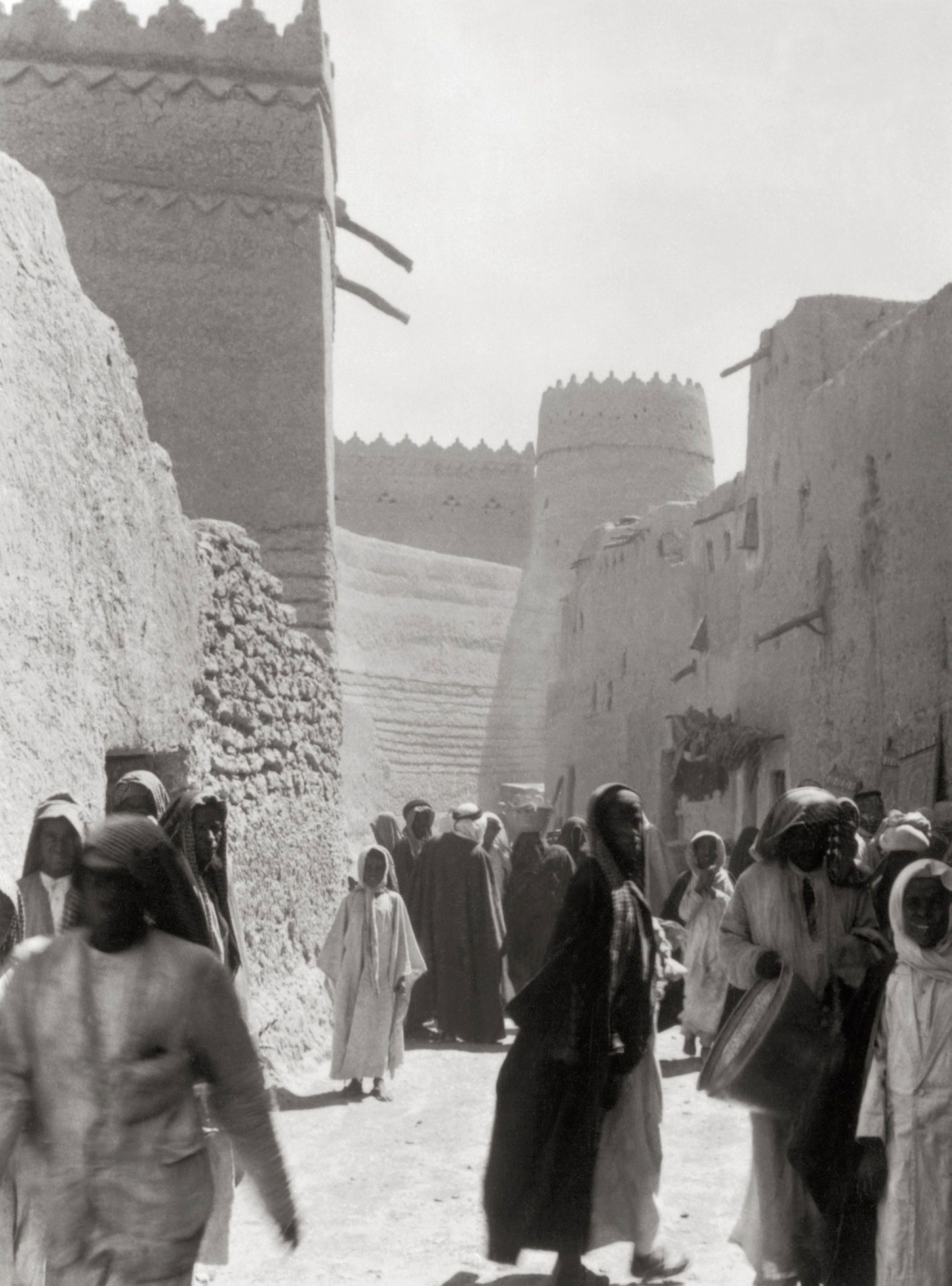
Geography of Riyadh City
Location and borders
Riyadh is located at the center of the Arabian Peninsula and is situated to the east of the Najd plateau. It descends towards the east at an elevation of approximately six hundred m above sea level. The city is located in the section known in geological studies as the Arabian Plate, renowned for its sedimentary rocks. Its location forms the tip of a triangle, bounded to the east by Wadi al-Batha and to the west by Wadi Hanifa, with its base extending to the north. Riyadh has a distinct strategic location, placing it approximately two hours by plane from all the inhabitants of the Arabian Peninsula, totaling around seventy-five million people.
Demographics of Riyadh
According to modern trends in city management, Riyadh is considered an icon that has evolved as a result of interconnected departments for over forty-eight years. Riyadh is viewed as the primary landscape reflecting the Saudi Vision 2030.
Among the cities of the Kingdom, Riyadh is distinct for its dynamic rates of population and urban growth. It is one of the fastest-growing capitals in the world, with an annual growth rate of up to 4 percent, which is higher than the national average growth rate of 2.11 percent. Riyadh is the largest urban area in the Kingdom and the most densely populated. Within its boundaries live 7,009,120 people according to the 2022 census, covering an area of no more than two thousand km², translating to an average of 4,659 people per km².
Riyadh also stands as the primary destination for internal migration within the Kingdom. Migrants make up 50 percent of its population, explaining the momentum and cultural diversity that the city experiences.
Climate
The climate in Riyadh is a continental desert, experiencing significant annual variation, as Riyadh is not near any water bodies that might influence temperatures. As such, the climate is hot and dry in the summer and cold in the winter. During the summer, temperatures can reach up to forty-eight degrees Celsius and gradually decrease in the fall. The lowest temperatures in the winter can drop below ten degrees Celsius during January. As for precipitation, it is relatively moderate, with an annual average of 84.4 mm.
Naming of Riyadh
The name Riyadh is relatively recent. Historically, it was called Hajar. This name persisted until the thirteenth century. Over time, it transformed into small villages comprising al-Ud, Muqrin, Mi'kal, Manfouhah, Jabrah, al-Masane', and Siyah. In the seventeenth century, the collective name for this group of villages became Riyadh. There's also a perspective on its naming that these villages were originally orchards and gardens inundated by rainwater, becoming a place where floodwaters gathered. However, in the springtime, they flourished with various plants, and hence, the name Riyadh was coined.
Princes who governed Riyadh Emirate
In the initial phase of the establishment of the Kingdom, the founder King Abdulaziz directly managed the affairs of Riyadh city. During his absence, his father, Imam Abdulrahman al-Faisal, undertook the responsibility. After his father's death in 1928, Prince Abdulaziz Bin Abdullah Bin Turki took over the administration of the city's affairs. Later, the responsibility shifted to Prince Saud Bin Abdulaziz once he became the crown prince. During the absence of both the King and the Crown Prince, the duty was delegated to a state official, Mohammad Bin Zaid.
The Emirate of Riyadh Province has been governed by Their Royal Highnesses: Prince Nasser Bin Abdulaziz (1937-1945); Prince Sultan Bin Abdulaziz (1945-1949); Prince Nayef Bin Abdulaziz (1949-1954); Prince Fawwaz Bin Abdulaziz (1960-1961); Prince Badr Bin Saud Bin Abdulaziz (1961-1962); the Custodian of the Two Holy Mosques, King Salman Bin Abdulaziz (then the prince), governed the Emirate of Riyadh twice, the first between 1955-1960, and the second between 1963-2011; Prince Sattam Bin Abdulaziz (2010-2012); Prince Khalid Bin Bandar Bin Abdulaziz (2012-2013); Prince Turki Bin Abdullah Bin Abdulaziz (2013-2015); and Prince Faisal Bin Bandar Bin Abdulaziz since 2015 until now.
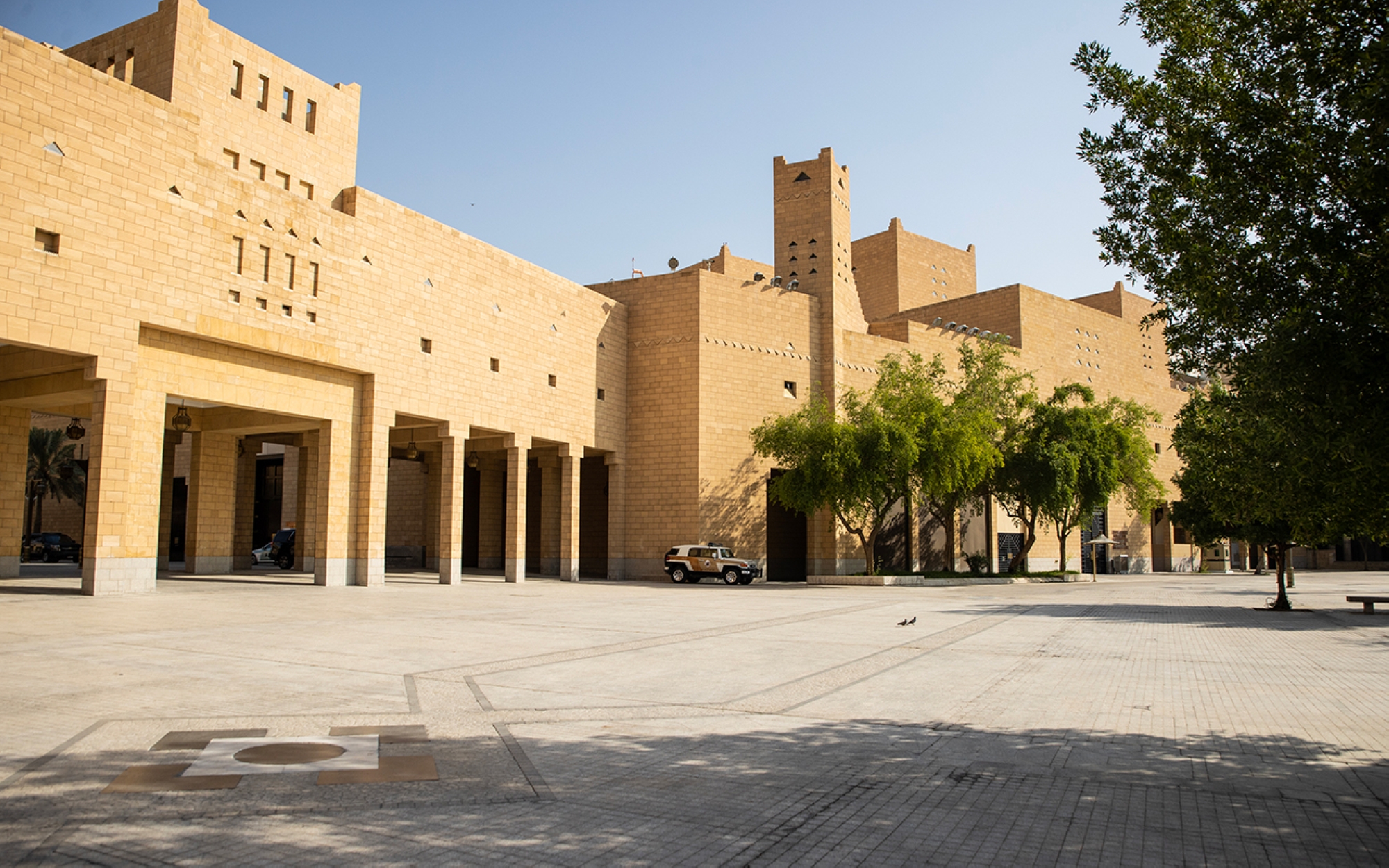
Economy of Riyadh City
Riyadh City is among the most diverse Saudi cities in the economic sector. The manufacturing industry sector is one of its prominent productive sectors, as it includes two industrial cities. The percentage of manufacturing industries in Riyadh is about 3.44 percent of the gross domestic product (GDP).
Moreover, Riyadh tops the list of cities in the Kingdom in terms of purchasing power, which determines the living standards of its inhabitants and their capacity to drive work economies. The average weekly expenditure in Riyadh, during September 2020, reached about SAR2,855 billion through point-of-sale transactions, an amount equivalent to the combined weekly expenditure in ninety-seven Saudi governorates.
When examining the daily activity at King Khalid International Airport, Riyadh is classified as a business hub, attracting a large number of individuals on workdays. The average number of daily flights in 2018 reached 583.
Riyadh was described in the 1970s as the world's largest construction site due to its rapid urban growth. Until the early 1980s, the city issued an average of a hundred building permits daily, a high rate compared to global averages.
Riyadh City hosted the G20 Summit in 2020 and is home to the headquarters of SABIC, one of the world's largest public companies listed on the Fortune Global 500. The city also houses government ministries, international missions, global organizations, and embassies, and is the headquarters of the Cooperation Council for the Arab States of the Gulf.
According to modern trends in city management, Riyadh is considered an icon that has evolved as a result of interconnected departments for over fifty years. This is under the administration of the Royal Commission for Riyadh City, organizationally linked to the King and the Crown Prince, with its board of directors chaired by Prince Mohammed Bin Salman Bin Abdulaziz Al Saud.
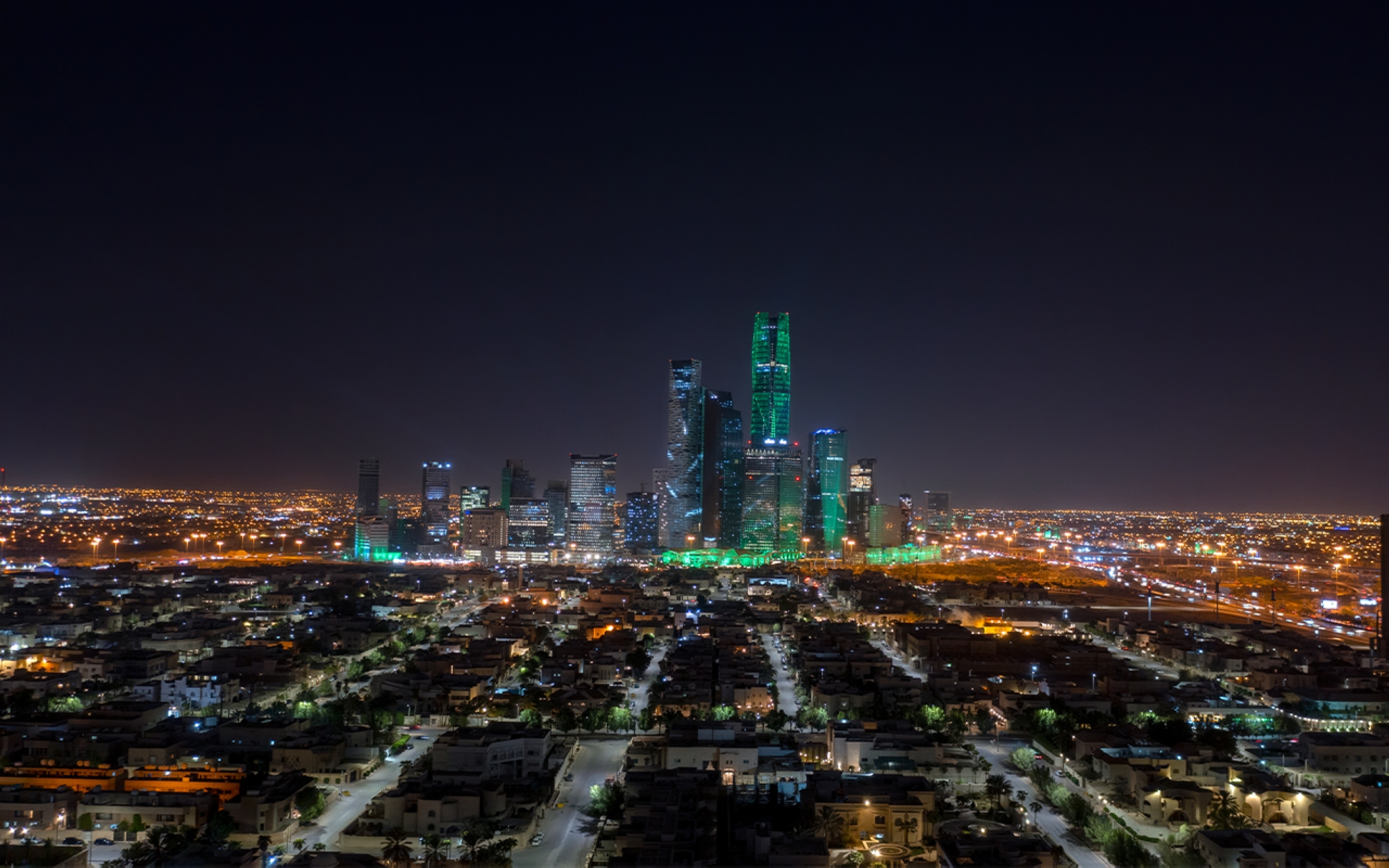
Riyadh city vision
During his participation in the fourth session of the Future Investment Initiative, Crown Prince and Prime Minister, His Royal Highness Prince Mohammed Bin Salman Bin Abdulaziz Al Saud, announced the vision for Riyadh City. He stated, "All of Riyadh’s features set the groundwork for job creation, economic growth, investment, and many more opportunities. Hence, we consider Riyadh with high regard."
The vision aims for Riyadh to be among the top ten economic cities in the world. The city's infrastructure is well-prepared, thanks to the efforts of King Salman, who has managed and planned for Riyadh City for over fifty-five years.
Riyadh sustainability strategy
In 2021, Prince Mohammed Bin Salman launched the Riyadh Sustainability Strategy, which includes the initiation of more than sixty-eight initiatives across five sectors: energy and climate change, air quality, water management, waste management, biodiversity, and natural areas. The strategy aims to reduce carbon emissions in the city by 50 percent, in addition to injecting SAR346 billion into the city's sustainability initiatives and projects and stimulating the private sector with investment opportunities.
Riyadh's developmental projects
King Salman Park Project
It is one of the four major projects for Riyadh city, launched by the Custodian of the Two Holy Mosques, King Salman Bin Abdulaziz, on March 19, 2019. The King Salman Park Foundation, headed by Crown Prince Mohammed Bin Salman, oversees it. The park is located at the heart of Riyadh city, specifically situated on the land of King Salman Air Base. It connects to six main axes, five metro network stations, and three Riyadh bus network stations. This allows 75 percent of the city's residents to reach it within thirty minutes. Upon completion, the King Salman Park will represent the largest urban park in the world, spanning an area exceeding sixteen km².
Green Riyadh Project
Every year, Riyadh City witnesses sandstorms due to its climatic nature. To combat these storms, the Saudi government has resorted to one of the most ambitious afforestation projects in the world. The name Green Riyadh Project refers to the widespread and intensified tree planting throughout the city and in its various regions. The project aims to combat desertification, and multiply the individual's share of green space in the city by sixteen times – increasing it from the current 1.7 m² to twenty-eight m² per capita according to the city's census as per the General Authority for Statistics report of 2017. Furthermore, the project seeks to raise the percentage of green spaces from the current 1.5 percent to 9 percent of Riyadh City's total area, equivalent to 541 km² upon completion.
The afforestation program includes planting more than 7.5 million trees, comprising seventy-two different species. Notable among these are native Sidr trees, Najdi Acacia trees, and Gulf Prosopis trees. It covers most elements and components of the city, including: 3,330 parks, forty-three large areas, nine thousand mosques, six thousand schools, sixty-four university and college facilities, 390 health facilities, 1,670 government facilities, 16,400 linear km of streets and roads, in addition to two thousand car parking lots, 1,100 linear km of green belts within public utility lines (electricity transmission towers and oil pipeline routes), 175,000 vacant plots of land, and 272 km of valleys and their tributaries.
Sports Boulevard Project
The Sports Boulevard Project enhances Riyadh's transformation into a modern global capital that achieves the highest standards of quality of life. It provides millions of amateurs and professionals with the opportunity to conduct competitions and activities, which include football, volleyball, walking, cycling, and horse riding. It enables its residents and visitors to engage in sports through open facilities and advanced amenities on a path leading them to better health.
The project spans an area of approximately 2.3 million m², with a length of about 135 km. It encompasses eight different zones, thirteen diverse stations, and a large collection of landmarks and centers that serve all segments of society. It also includes 4.2 million m² of green spaces, 120,000 trees, and fifty sports facilities.
Riyadh Art Project
The project adds a distinct aesthetic dimension to Riyadh City through diverse artworks created by both Saudi and international artists. Upon its completion, the project aims for Riyadh to become an open art exhibition accessible to millions of visitors around the clock, with more than one thousand artworks spread throughout its facilities, neighborhoods, and squares. This is achieved through ten programs, namely: Urban Art Lab, Garden City, Noor Riyadh, Jewels in Riyadh, and at the forefront is the Riyadh Icon; an artwork specifically designed to symbolically represent the Saudi capital when evoked.
New Murabba
The New Murabba project represents the largest modern downtown globally. It is located to the northwest of Riyadh city at the intersection of King Salman Road and King Khalid Road, spanning an area exceeding nineteen km², with a floor space reaching more than twenty-five million m². The project is designed in a way that aligns with sustainability standards and elevates the quality of life, emphasizing health, sports, and community activities.
The project includes 104,000 residential units, nine thousand hospitality units, and commercial spaces extending over 980,000 m², in addition to 1.4 million m² of office spaces. Alongside this, there are approximately 620,000 m² dedicated to entertainment facilities and about 1.8 million m² for community facilities. The project also houses an innovative museum, a university specializing in technology and design, a comprehensive multi-purpose theater, and over eighty areas for live shows and entertainment.
Qiddiya
It is a massive entertainment project and is one of the megaprojects announced by Crown Prince Mohammed Bin Salman, on April 7, 2017. Located southwest of the capital, Riyadh, its goal is to be the largest quality cultural, sports, and entertainment city in the Kingdom. The project encompasses several entertainment facilities, including amusement parks, water parks, natural landscapes, cultural activities, sports areas, and car and bike riding tracks. A racetrack will be built according to the International Automobile Federation F1 standards, and it is expected that a Formula 1 race or a MotoGP race will be held in Qiddiya in the coming years. By 2030, Qiddiya will also be capable of hosting numerous global sports competitions and a wide range of activities.
Education in Riyadh City
Public schools in Riyadh City are among the most densely populated in the Kingdom in terms of student numbers. Regarding academic education, Riyadh City witnessed the establishment of the first Saudi university, King Saud University, in 1957. The city is also home to the Kingdom's first and the world's largest women's university, Princess Nourah Bint Abdulrahman University, spanning an area of eight million m².
Public education
The first formal school in Riyadh City was established in 1930, named Princes' School. The Custodian of the Two Holy Mosques King Salman Bin Abdulaziz Al Saud received his early education there. There, he studied religious sciences and Hadith sciences and completed memorizing the entire Holy Quran at the age of ten.
Riyadh's schools are among the most densely populated in the Kingdom in terms of student numbers. They accommodate approximately 1,196,129 male and female students. Out of this, 518,821 male students attend 2,230 schools, while 677,308 female students study in 3,469 schools. In total, there are 5,699 schools in Riyadh, according to the statistics of the Ministry of Education for 2022.
University education
Riyadh City is home to five public universities: Imam Mohammed Bin Saud Islamic University, King Saud University, Princess Nourah Bint Abdulrahman University, King Saud Bin Abdulaziz University for Health Sciences, and the Saudi Electronic University. In addition to these, there are ten private universities and colleges, making Riyadh the city with the highest number of universities and colleges in the Kingdom.
Riyadh also hosts a number of military colleges, including King Faisal Air Academy, King Khalid Military College, King Abdulaziz Military College, in addition to King Fahd Security College. Students from various cities and governorates of the Kingdom enroll in these institutions.
According to the statistics of the Ministry of Education for 2017-2018, the total number of male and female students in Riyadh City's universities is approximately 377,513. Out of these, 63,177 are newly enrolled, and 314,336 are registered students, while the number of graduates amounted to 46,488 male and female graduates.
Libraries
In 1943, the first public library in Riyadh City was established, founded by Prince Musaid Bin Abdulrahman. He dedicated a wing of his palace for reading, in addition to employing a staff member to manage its affairs. Riyadh is home to King Fahd National Library. This institution contributes to enriching the scientific and research activities of students and researchers in Riyadh. It offers various sources and mediums of information across several fields. In addition, the library provides numerous digital resources through its Digital Library Project and the MASDAR Project.
Research centers
There are many research centers and institutes in Riyadh, which contribute to the field of research education and specialize in various fields, such as medicine, engineering, human and social studies, and others. Among these centers: King Saud Medical City Research Center, research centers affiliated with King Saud University, King Abdullah International Medical Research Center, in addition to the King Abdullah Institute for Nanotechnology.
Transportation in Riyadh City
The transportation system in Riyadh City is divided into two main sections: air transport and land transport. Several entities work on the development of this system in Riyadh City, in addition to supervising it, including the Royal Commission for Riyadh City, the General Transport Authority, and the Ministry of Transport.
Public transportation
The means of land transportation in Riyadh City vary, including metros, cars, and buses. The Saudi Public Transport Company (SAPTCO) is the entity responsible for all matters related to public transportation via buses and has several branches and stations distributed throughout Riyadh. Meanwhile, the number of cars is estimated to be around two million vehicles, and the number of trips on the road network within Riyadh is estimated at about nine million trips daily.
Riyadh also boasts the Wadi Leban Bridge, which is considered one of the largest suspended bridges in the world and the largest bridge in the Kingdom. It was inaugurated in 2000. The bridge extends for 763 m and has a height of ninety m, playing a crucial role in reducing traffic congestion.
King Khalid International Airport
It was inaugurated at the end of 1983 and comprises five main halls, in addition to forty air bridges. The airport facilitates over 217,000 flights annually, serving more than fifteen million passengers each year. The airport also includes a number of air cargo companies that receive and export shipments worldwide.
Riyadh Metro
Riyadh Metro (Riyadh Train) is the first project in the Kingdom to feature railway tracks passing through underground tunnels, with depths ranging from twenty to thirty-five m below the surface. The system operates automatically (driverless) and is controlled from central control rooms. The trains have a uniform design, with a total of 338 carriages, giving them a distinctive appearance.
The Riyadh Metro has a track length of 176 km, with about forty km of the tracks running underground, while the rest of the tracks either run at ground level or on bridges. The metro comprises eighty-five stations, all of which are located within the city of Riyadh, some of which are underground.
It was inaugurated by the Custodian of the Two Holy Mosques, King Salman bin Abdulaziz Al Saud, on November 27, 2024.
His Royal Highness Crown Prince Mohammed bin Salman bin Abdulaziz Al Saud, Prime Minister and Chairman of the Board of Directors of the Royal Commission for Riyadh City, stated that King Salman has supported the public transportation project in Riyadh, encompassing both the metro and buses, from its inception as an idea to its realization on the ground. This was achieved in line with his wise directives to complete the project according to the highest international standards and in the best possible manner, ensuring it serves the residents and visitors of Riyadh City effectively.
Architectural heritage and urban styles in Riyadh city
Riyadh possesses the largest share of historical landmarks and significant symbols in the history of the Kingdom. The most prominent of these is al-Murabba area, which houses al-Murabba Palace, constructed by King Abdulaziz Al Saud. This palace marked the first step in Riyadh's urban expansion; it was the first building constructed outside the walls of old Riyadh. The area features diverse architectural styles, from traditional heritage architecture to international multicultural architecture, to modern architecture that stands out with its high-tech features.
Urban styles
The traditional architectural style in Riyadh City persisted until the 1950s. After that, modern building materials were used on a limited basis. In the 1970s, urban development took place, and the old walls of Riyadh City were removed. In the 1990s, guiding plans emerged aiming at urban orientation. Subsequently, architectural developments followed, based on plans, strategies, and modern methods.
Najdi architecture is one of the heritage urban styles of Riyadh City. It is characterized by simple construction inspired by the desert environment. Houses were typically one or two stories and included an open courtyard surrounded by rooms. What distinguishes this architectural style is the abundance of interior decorations of the houses in contrast to the exterior, with windows, doors, and ceilings adorned in various colors.
Due to the evolving architectural heritage in Riyadh City, specialists have termed the urban style in Riyadh as 'Salmani Architecture.' This label emerged from the developmental vision of the Custodian of the Two Holy Mosques King Salman Bin Abdulaziz Al Saud in modernizing and developing the urban identity of Riyadh City. He highlighted the local heritage identity in various projects during his emirate period, which lasted for more than fifty years.
Prominent projects that have adopted the Salmani architectural style in Riyadh City include al-Hukm Palace area, the King Abdulaziz Historical Center, the Diplomatic Quarter, and the building of the Ministry of Foreign Affairs. In addition to these is the SEDRA neighborhood, being constructed by Roshn Company (owned by the Public Investment Fund), aiming to build over thirty thousand homes with modern urban designs that blend the city's identity with contemporary construction standards.
Historical palaces in Riyadh city
Several palaces with significant historical standing were constructed in Riyadh City. These palaces played pivotal roles in the saga of the founding and unification of the Kingdom and its early inception. Among the most notable is al-Masmak Palace, which is closely associated with the event that paved the way for the declaration of the modern Saudi state and the unification of the rest of the Kingdom's regions. It is significant as the gateway through which King Abdulaziz Bin Abdulrahman Al Saud entered during his recapture of Riyadh City in 1902.
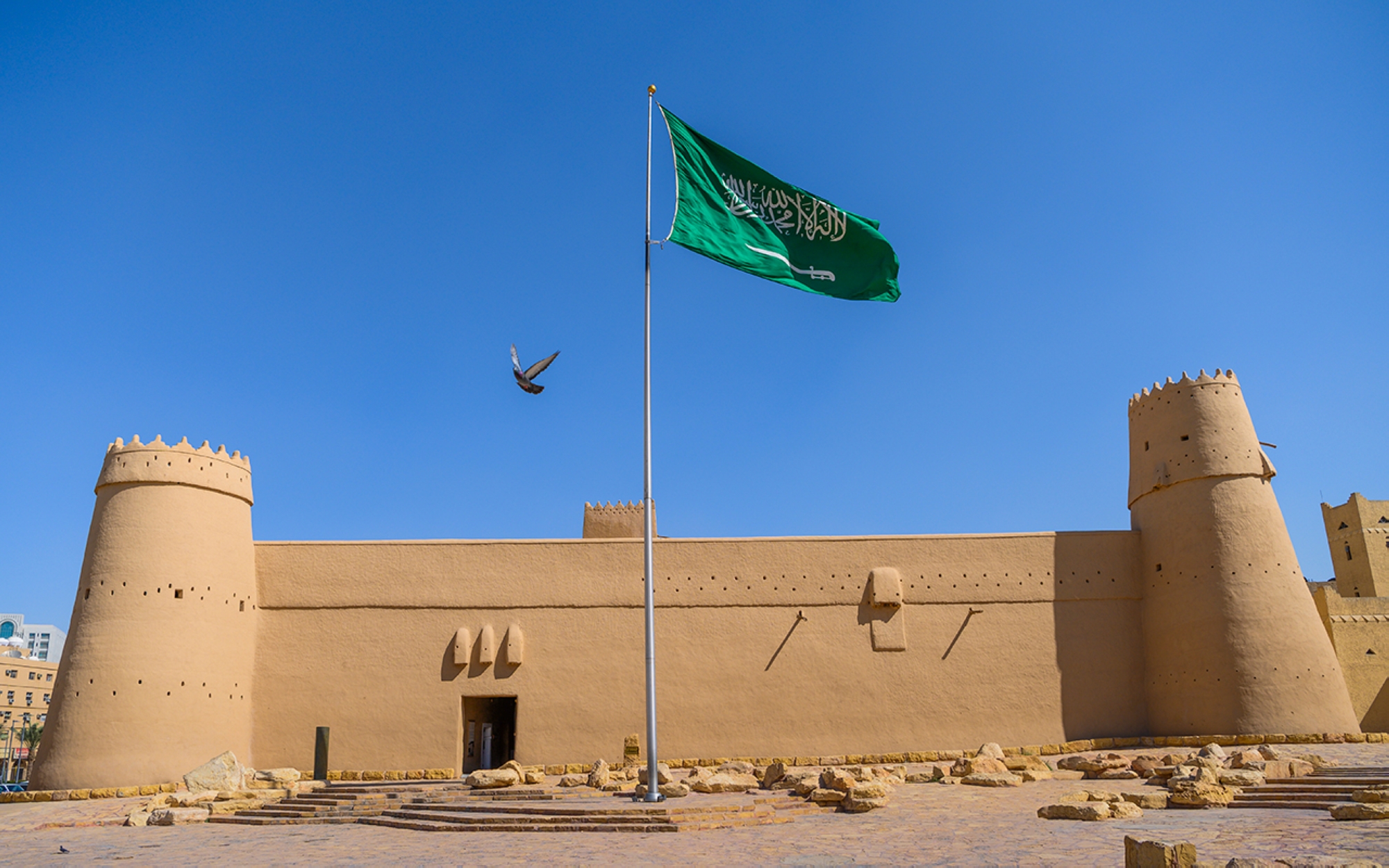
Al-Badi'ah Palace is another historical royal palace commissioned by the founder King Abdulaziz Bin Abdulrahman Al Saud. It was built to serve as a venue for royal hospitality, management of citizens' affairs, and hosting private meetings. The palace is located in Riyadh City, in the Kingdom's Riyadh Province.
The Red Palace represents the residence commissioned by the founder King Abdulaziz for his son, King Saud, when he was the crown prince. This construction was ordered after his residence in al-Murabba Palace was destroyed by fire. The palace was completed in 1948. The palace is known for its reddish hue, deriving its name from its distinctive color.
Located in Riyadh City are also Abu Jifan Palace and the Palace of Princess Nourah Bint Abdulrahman (al-Shamsiya Palace), in addition to several heritage palaces situated in Riyadh City center. Among them are the seven palaces in western Futah, which date back to 1943, and the three palaces in eastern Futah, which trace their origins to 1935. Furthermore, there are the royal palaces: King Fahd Palace, King Abdullah Palace, Princess Haya Bint Abdulrahman Palace, Prince Sultan Palace, and Princess al-Anoud Palace.
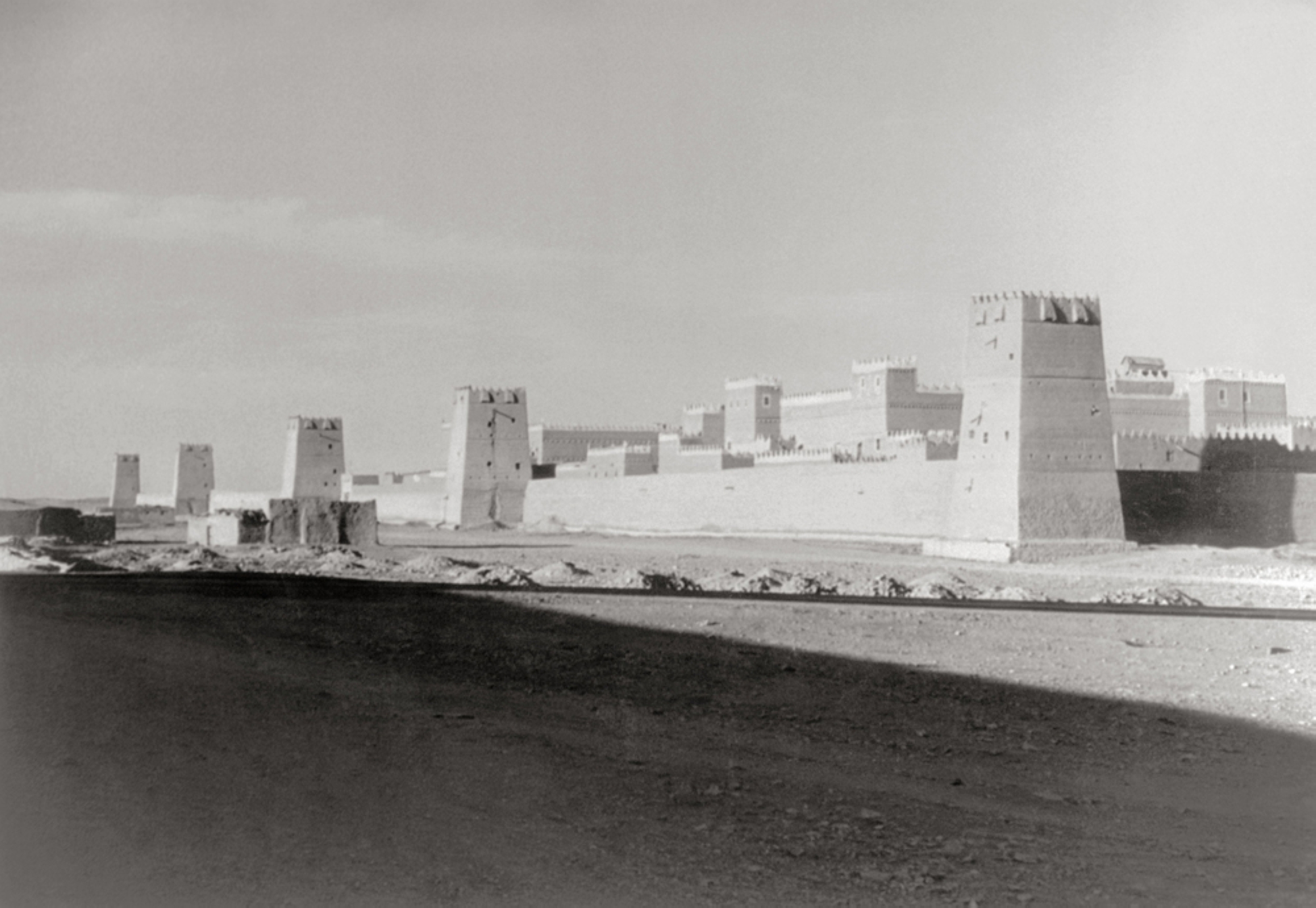
Historic mosques in Riyadh city
Historic mosques are among the prominent landmarks in Riyadh City. Some have witnessed pivotal historical events, such as Imam Turki Bin Abdullah Mosque, known as the 'Grand Mosque,' and Sheikh Mohammed Bin Ibrahim Mosque, located in al-Hokm Palace area. Other notable mosques include King Abdulaziz Mosque, al-Madi Mosque, situated in the eastern part of the King Abdulaziz Historical Center, and Imam Mohammed Bin Saud Mosque.
Culture in Riyadh city
Riyadh City was chosen as the Capital of Arab Culture for the first time in 2000. The National Theater represents the activation of cultural, historical, and global events.
Riyadh International Book Fair (RIBF)
Annually held in Riyadh City, it is considered one of the most important Arab book fairs in terms of visitor numbers, sales volume, and the diversity of cultural programs. The fair also boasts participation from some of the most prominent Arab, regional, and international publishing houses. The fair is a significant cultural event on the Arab cultural scene and serves as a platform for companies, institutions, and individuals involved and interested in the sectors of literature, publishing, and translation to showcase their works and services. In addition to its primary role, the fair also aims to enhance and nurture the passion for reading within the community, promoting cognitive, cultural, literary, and artistic awareness.
Museums
The Saudi National Museum represents the official museum of the Kingdom and is one of the prominent national landmarks. It is part of the King Abdulaziz Historical Center in al-Murabba district. It was built over an area of 17,000 m² and inaugurated in 1999. It is located on the eastern side of the main square of the King Abdulaziz Historical Center. Also in Riyadh is al-Masmak Historical Museum, which specializes in the story of the unification of the Kingdom; it was opened in 1995. Additionally, there's the Archaeological Museum at King Saud University, which houses one of the largest archaeological collections in the Kingdom, consisting of ancient artifacts directly related to the history of the Kingdom.
Riyadh houses several museums specialized in showcasing aircraft, memorabilia, and historical documents of the Royal Saudi Air Force, such as the Saqr al-Jazira Aviation Museum, which was inaugurated on January 24, 1999, coinciding with the centennial celebrations of the conquest of Riyadh.
Furthermore, there are also numerous specialized museums represented by government entities and institutions. Among them are: the King Abdulaziz Memorial Hall at the King Abdulaziz Foundation for Research and Archives (Darah), the King Abdulaziz Museum, the Museum of the History of Science and Technology in Islam, the Currency Museum, the Post Museum, al-Faisal Museum for Arab-Islamic Art, the King Fahd National Library Museum, King Fahd Security College Museum, Oasis of Science Museum, and the Zoology Museum.
In Riyadh City, there are also a number of private museums. These diverse museums, owned by citizens, showcase their private collections related to history and heritage. Among them are: the Peninsula Museum, Mushawih al-Mushawih Museum, and the Heritage Museum for Arts and Crafts.
Cultural centers
Located in Riyadh City are several cultural centers that contribute to enriching the cultural and artistic movement. These centers might include certain cultural facilities, such as libraries, theaters, and museums. Moreover, these centers play an active role in hosting cultural activities and events. The King Fahd Cultural Center is one of the cultural centers in Riyadh City. It was established on November 21, 2000. The center is concerned with organizing cultural, scientific, and artistic activities. It includes two theaters, a library, a museum, an astronomical dome, a photography studio, halls dedicated to hosting exhibitions, and several administrative and service facilities.
Also located in Riyadh City is the King Abdulaziz Historical Center, which stands as a national landmark and represents a cultural and civilizational facade in the Kingdom. Situated in the historic al-Murabba district in central Riyadh, it opened on January 22, 1999. The center is dedicated to enhancing the national value of the Kingdom and its culture and civilization.
The center includes a number of cultural facilities and institutions, such as Darah, King Abdulaziz Library, a lecture hall, and several important historical structures, the most prominent of which is al-Murabba Palace. The National Museum is one of the most notable cultural elements and establishments of the center.
Tourism in Riyadh city
The capital embraces the Riyadh Season, the first edition of which started in 2019. It attracted over eleven million visitors to its diverse events, including entertainment, music concerts, local and international exhibitions, theatrical performances, and sports tournaments.
Riyadh is known throughout the Kingdom as a center for fine dining quality, embracing new culinary habits and techniques. According to the global website TripAdvisor, 1,255 restaurants in Riyadh have received high ratings, which is the highest number of restaurants among the cities of the Kingdom.
Riyadh is also considered a specialized medical destination in the Kingdom and the Middle East. It houses forty-five major medical facilities, several of which have received global ratings for treatment quality. The city has gained international recognition for hosting some of the most significant conjoined twin separation surgeries in the world.
Riyadh Season
Riyadh City launched the largest tourist season in the Kingdom, initiated by the General Entertainment Authority, to develop and flourish the tourism and entertainment sector. The goal was to make the Kingdom one of the most prominent local and global tourist destinations. The events were held over an area of about fourteen million m² and were launched under the slogan 'Imagine.' The number of events during the season reached around one hundred events, catering to all age groups and covering a broad spectrum of fields, such as culture, art, sports, and specialized exhibitions.
Around 280 Saudi companies, in addition to organizing government entities, worked on the implementation of the Riyadh Season. The season provided employment opportunities for those seeking seasonal or part-time work. The number of seasonal jobs reached approximately 24,000, while part-time jobs amounted to around 22,000 positions.
The number of visitors to the first edition of the Riyadh Season, held in 2019, reached eleven million visitors and approximately two hundred thousand tourists. Direct income amounted to about SAR1 billion, while indirect income reached about SAR4 billion. The season established various partnerships globally, involving seventy companies. Additionally, it attracted twenty-six international restaurants from countries including Mexico, Japan, India, France, and the United States.
The third edition of the Riyadh Season in 2022 encompassed fifteen entertainment zones with event days totaling over 8,500. The season featured various locations, including seven international exhibitions, 240 stores, and 252 cafes and restaurants. Its events were diverse, with more than 150 musical performances, 108 interactive experiences, seventeen Arabic plays, and eight international shows.
Tourist landmarks
Riyadh City hosts several landmarks that serve as major tourist attractions. Among the most prominent is the Kingdom Tower, one of the world's most significant skyscrapers. It was inaugurated in 2002 and symbolizes the modern architectural progress in the Kingdom. At the top of the tower is the Sky Bridge, a steel structure that is sixty m long, weighing approximately three hundred t, and offering a panoramic view.
Among the tourist attractions is also al-Faisaliah Tower, which represents the first skyscraper built in the Kingdom. It was inaugurated in 2000. The tower comprises thirty floors, reaching a height of 267 m. As the tower ascends, the floor space of its levels decreases. At its summit, there is a glass sphere with a diameter of twenty-four m.
Another significant geological landmark in the city is the Tuwaiq Mountain. In the twenty-first century, it has become one of the most recognized cultural icons of the Kingdom, known for its touristic, historical, and social significance.
Among the most notable historical landmarks that hold great tourist value for Riyadh City are al-Masmak Palace and al-Hukm Palace. Together, they represent some of the most important tourist areas that showcase the history of the Kingdom and Riyadh City in particular.
Camping is one of the most prominent tourists and recreational activities known to the residents of Riyadh City. In the local dialect, it's called kashtha. The concept revolves around spending a night or more away from home, and it can extend over several days. Any location where a tent is set up is referred to as a camp. Given Riyadh City's desert landscape, camping is typically associated with the winter season. The city is characterized by its various camping spots, such as the King Khalid Royal Preserve, or as it's locally known, ath-Thumamah Desert Park.
Sports in Riyadh city
Riyadh City represents a destination for enthusiasts of various sports, including football, equestrianism, and camel racing. The city is also home to three of the most popular football clubs in the Kingdom. King Fahd International Stadium is located in Riyadh, the largest stadium in the Kingdom in terms of capacity.
Sports facilities
Riyadh City has several stadiums dedicated to various types of sports. King Fahd International Stadium, with a seating capacity of 68,752, is the largest stadium in the Kingdom. It was built in 1987. The stadium serves as the headquarters for several clubs representing Riyadh City, most notably: Al-Hilal Club, al-Nassr Club, and al-Shabab Club. The stadium is primarily used for football matches. The first match held at this stadium was between the Saudi national team and the Omani national team during the Gulf Cup in 1988, which ended in a victory for the Saudi team.
Riyadh City is home to the Prince Faisal Bin Fahd Stadium, which was established in 1971. It has a seating capacity of 22,500 seats. Around the stadium, there are several facilities and establishments, the most important of which are: a secondary grass football field, an indoor sports hall for gymnastics, the royal lounge building, the Saudi national football team camp building, and the Billiards and Snooker Federation building.
Riyadh-based clubs
Four clubs consider the city of Riyadh their original home. These are: Al-Hilal Club, founded in 1957; al-Nassr Club, founded in 1955; al-Shabab Club, established in 1947; and al-Riyadh Club, founded in 1953.
Equestrianism in Riyadh City
In Riyadh City, several horse races take place, with the most prominent being the Saudi Cup for horse race, which is considered one of the world's most lucrative horse racing championships in terms of prize money. The total prizes for the Saudi Cup in 2021 reached around SAR114 million, while in the first edition in 2020, it was about SAR109 million. The race took place at the King Abdulaziz Equestrian Field, organized by the Horse Racing Club, with participants from both locally and around the world.
Meanwhile, the King Abdulaziz Equestrian Field in Riyadh City is one of the most important horse racing centers in the Kingdom. It represents a cultural symbol of the Kingdom in the field of equestrianism. The field consists of sandy tracks surrounding a green area. Within the field, there's a grandstand that accommodates five thousand seats overlooking the track and the finish line.
Related quizzes
Related articles


